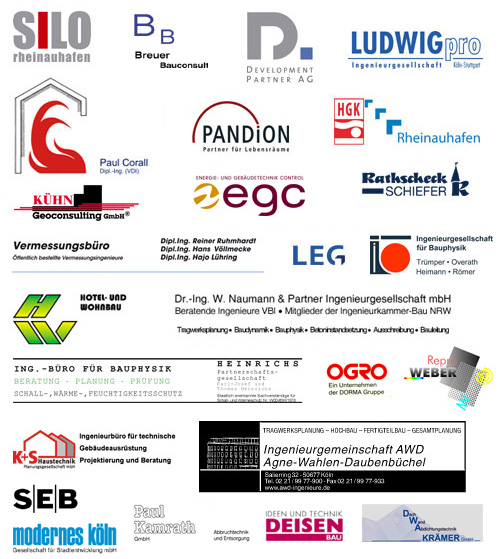kister scheithauer gross, Köln
In the pair of catalogs and exhibitions “Buildings and Projects for Halle” and “Double Church for Two Confessions” in Freiburg, Aedes was primarily concerned with the new buildings of kister scheithauer gross. The current exhibition deals with the conversion of older buildings to serve new functions — a topic of great urgency not only in German cities, but throughout Europe, and one that will fundamentally determine the future of the urban environment.
On the basis of outstanding examples, this exhibition of projects by this Cologne architectural office focuses on “typological transformations” — as Johannes Kister refers to them. At the center of the presentation stands the so-called “Siebengebirge,” completed in June of this year, a former Cologne warehouse owned by the National Emergency Reserve, which sits on the banks of the Rhine. The ground floor is being converted into a string of restaurants and shops, while the upper stories are being remodeled as premium apartments enjoying river views.
The conceptual and design abilities of the kister scheithauer gross practice are not only in evidence in this enormous facility. The conversion of a silo also demonstrates their approach to the challenges represented by the typological transformations of older architectural substance in urban contexts.
Up until German reunification, the warehouse building “Siebengebirge” contained wheat for the national security reserve. Given its extreme depth and the concomitant challenges in the area of lighting, the building was long regarded as being unamenable to conversion. Meanwhile, an application had already been approved for the demolition of the neighboring silo building. This was prevented at the last minute, when awareness grew that these structures were indispensable elements of Cologne’s Rhine River silhouette. Meanwhile, both conversion planning and construction activities have been accompanied by considerable interest on the part of the local populace.
Historically, the reinforced concrete warehouse, erected in 1908 – 1909 by Hans Verbeek as the “Danziger Lagerhaus,” is highly significant with respect to both design and constructive technology. The deliberations concerning the granting of protected landmark status and the requirements for new residential use fundamentally conditioned planning work and allowed novel solutions to emerge.
Cologne’s planning for the banks of Rhine is not always free of controversy and debate. Nonetheless, projects have been realized there that can be regarded as highly successful rescues of architectural substance previously deemed virtually lost. This fact is owed primarily to courageous clients, PANDION in the case of “Siebengebirge,” and Development Partner AG and LEG for the silo. Here we find a successful instance of an architecturally demanding conversion and the revitalization of an urban locale that was propelled by economic interests.
And if the architectural structure of the Siebengebirge was fundamentally reutilizable, then the tubular bundles of the silo hopper are, at first glance, hardly amenable to transformation. With the collaboration of structural engineer K. H. Breuer, a successfully conversion concept was developed that makes possible modern, flexible office levels within, while the installation of new windows into the emblematic silhouette achieves a new and incisive plasticity.
Both projects demonstrate that the substance of existing structures represents
a “reserve” that permits the kinds of functional transformations that necessitated by the internal development of cities. The exploitation of surfaces in outlying districts represents no alternative to the revitalization of the inner city. Such transformations may involve residences, as well as new structures that integrate residential and work functions, including small-scale commercial surfaces.
Both buildings will be completed by late 2006 or mid 2007.
The projects will be presented through working models, photographs and plans.
Speaking at the opening will be:
Kristin Feireiss Berlin
Councilman Bernd Streitberger Head of Urban Development, Planning and Building for the City of Cologne
Further infos: [email protected]
Diese Ausstellung wurde ermöglicht mit der großzügigen Unterstützung von:
